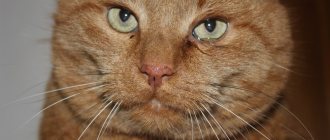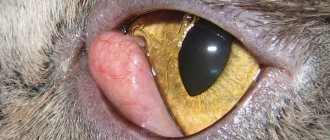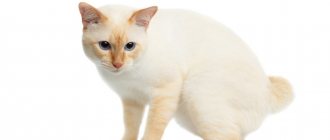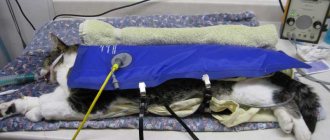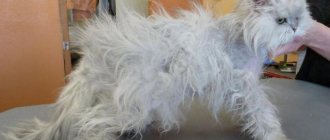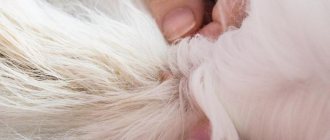10117Pavel
Discharge from your pet's eyes is normal if it is clear and small in number. You should be wary if you notice black discharge from your cat's eyes.
Transparent liquid in the eyes may appear as a result of a reaction that protects the animal’s eyes from environmental factors (wind, dust). The same reaction can occur if an irritant gets into your pet’s nose. In Persian cats, lacrimation occurs after sleep. This is due to the structural features of their heads. That is, if the animal feels well and the fluid released from the eyes is clear, then the cat is healthy. If it has acquired a certain shade, then it’s time to start worrying.
© shutterstock
Symptoms - how to understand that your cat is sick.
There are many unpleasant diseases that can affect your pet's vision. It is important to recognize them in time and seek qualified help, because the lack of treatment or untimely intervention by a specialist will aggravate the situation and even lead to complete or partial loss of the pet’s vision.
You should be seriously concerned about the condition of your furry friend if you notice the following symptoms:.
- Brown discharge from a cat's eyes, often mixed with pus, indicates the presence of a bacterial infection in the animal's body. Additional symptoms in this case may include lethargy and nasal discharge.
- Clear discharge, as well as abundant and thick discharge, warns you of a viral infection.
- Brown discharge most often appears when the tear ducts malfunction.
- If a cat has swollen eyes and waters with ordinary tears, without any admixture of pus, but in large quantities, she sneezes and itches, then most likely this is an allergic reaction. This disease is also heralded by redness of the eyelids and their swelling.
- Reddish discharge from the eyes can easily be confused with brown if the cat has a dark fur color.
- Watch his reaction to others - is the cat making contact or has he become unsociable?
- Has his appetite changed?
- Check for scratches and other mechanical damage near the eyes.
- Try to find out what color the discharge from the pet’s eyes is, and whether there is any admixture of pus in it.
Perhaps they are not so pronounced, and it is difficult for you to decide what exactly is bothering your pet. In this case, it is worth observing his behavior.
If all these symptoms are absent in your case, and the cat’s eyes are watering with ordinary transparent tears, then there is no reason to panic. There are a number of reasons why even a healthy animal can have watery eyes. This is an unsuitable diet, characteristics of the breed, an allergic reaction to certain components or substances.
The most common eye diseases in pets
Conjunctivitis
Inflammation of the inner lining of the eyelid, the symptoms of which are redness, swelling of the eye and purulent discharge. There are many possible causes of the disease: infections, parasites, irritating drugs, bruises, foreign bodies, lime dust, smoke, ultraviolet and x-rays, mold fungi.
Keratitis
Inflammation of the cornea, the main symptom is that the eye begins to become cloudy and watery. The animal's behavior changes, the pet is worried due to constant pain, and photophobia develops. Causes: infection or injury.
Entropion and eversion of the eyelid
Signs: eyelashes and the edge of the eyelid are wet and turned inward or turned outward. There is lacrimation and redness of the conjunctiva. Because of this, keratoconjunctivitis (simultaneous inflammation of the cornea and conjunctiva of the eye) may develop. Causes: injuries, chemical and thermal burns, germs, viruses and some parasites.
Cataract
A cataract is a clouding of the lens. Its symptoms are not obvious, since the processes occur inside the eye for quite a long time. The lens becomes white or bluish. Older cats and dogs often suffer from cataracts. In the final stages of the disease, the animal has difficulty seeing in the affected eye. Causes: past infections, as well as inflammation and trauma.
Glaucoma
An eye disease caused by increased intraocular pressure. The main symptom is a constant or periodic increase in pressure inside the eye. Symptoms include clouding of the cornea and decreased sensitivity. At the same time, the eye greatly enlarges and hardens. Causes: complications of deep purulent keratitis, hemorrhage or lens dislocation.
Alexey Shilkin also notes that damage to the eyeball is common in animals. This is not necessarily associated with fights - due to their curiosity, dogs and cats often like to dig in the grass in the warm season.
This can be dangerous: according to the ophthalmologist, pets often injure their eyes on the remains of mown grass or thorns. The stems are infected with pathogenic microflora, which destroys the surface of the cornea at the site of injury. The infection quickly spreads throughout the eye. In some cases (for example, with panophthalmitis), it is not always possible to save the eye.
If a disease is detected, the owner should consult an ophthalmologist. This will allow you to help your pet as quickly as possible, as well as reduce the risk of relapses and complications. Ophthalmologist Evgenia Biryukova advises, for preventive purposes, to bring your pet for an examination once a year, until the pet is 7 years old. After 7 years, more often - once every 6 months.
Why a cat's eyes are running - possible reasons.
An ordinary healthy cat always secretes a clear liquid secretion from the organs of vision, but it is almost unnoticeable. Those rare cases when a pet exhibits profuse lacrimation are also considered normal. This happens due to the negative influence of external factors such as smoke, dust, harsh lighting or caustic chemicals, and poor hygiene. As a rule, after the cat returns to its normal environment without external stimuli, the production of tears stops.
You should be concerned when a cat develops dark discharge from the eyes, as this is direct evidence of the presence of an infection in the animal’s body. If you notice cloudy, brown, white or red discharge from your pet, immediately seek help from a specialist and do not try to treat the animal yourself at home.
If there is a bacterial infection in the animal’s body, not a viral one, you will notice discharge from the eyes that differs from tears. They can also be white or yellowish in color and cause inflammation in the area.
There are a number of diseases that can cause disruption of the tear ducts in cats:
- This is the formation of tumors and neoplasms that compress the channels.
- Allergy to external irritants or food. This reason is one of the most common.
- Non-infectious inflammation of the lacrimal sac.
- Physical trauma to the eyes.
- A foreign object that has entered the lumen of the lacrimal canal.
- Stenosis of lacrimal openings.
- Narrowing of the tear ducts due to inflammatory processes in the body.
- Infectious conjunctivitis.
- Inflammation of the eyelids.
- Incorrect growth of eyelashes (trichiasis).
- Damage to the cornea.
- Disease of the eye vessels.
- Glaucoma.
- Breed predisposition. Some cat breeds, such as Persian or British, have a brachycephalic skull structure, which causes them to have a shortened tear duct and increased tear production.
- Helminthic infestations.
- Immunity problems. It is most common in kittens and older cats who often have colds, causing them to have excessive watery eyes.
Do not forget that whatever the cause of the disease, prolonged absence of proper treatment will worsen the situation. All this time the animal will experience discomfort. As a result, the cat will begin to scratch the sore eye, scratching it into wounds and increasing the area of infection with microbes.
Hyphema
Hyphema is a pathological condition in which the anterior chamber of the eye begins to fill with blood. This is a very serious condition, since the fluid inside the eyeball is normally completely transparent. Its transparency is necessary so as not to interfere with the passage of light. If blood gets into the eye fluid, the light does not reach the lens at all, causing the animal to go completely blind.
The reasons for the development of hyphema are quite diverse:
- Injuries.
- Uveitis, iridocyclitis (inflammation of the eyeball itself and its vascular network).
- Various neoplasms.
- Systemic pathologies, including diabetes, blood clotting problems, autoimmune diseases, etc.
Degrees of hyphema development
The symptoms of the disease are quite simple: the eye is completely filled with blood, in severe cases it looks like a cherry. In addition, we already recalled above that the initial stages of hyphema may be accompanied by the appearance of small red dots or stripes on the surface of the eye.
All this depends on the specific stage of the hyphema:
- There are dots or stripes on the surface of the eye, up to ¼ of the eye chamber being filled with blood.
- The second stage is from 1/3 to ½ filled with blood.
- In the third stage, the eyeball is more than half filled with blood.
- The eye turns into a “blood ball”, the gaps are completely absent, the animal goes blind.
Treating a cat at home.
In order to decide how to treat your pet at home and not cause further damage to it, be sure to first consult with a veterinarian. After the necessary tests and a thorough examination, your cat may be prescribed antibacterial or antiviral treatment, as well as drops, antibiotics or special anti-inflammatory ointments. In some cases, the animal is prescribed physical therapy or surgery.
If your cat has constant excessive tearing and there are scabs in the corners of the eyes, or the cat has swollen eyelids, dark discharge with an unpleasant odor, or blurred vision, then you should take her to a specialist. Pay attention to the pet's body temperature and general condition. Fever, lethargy, depression, sneezing, and refusal to feed are all symptoms of the disease that require detailed study.
You should also contact your veterinarian immediately if your cat has a foreign object in its eye. Under no circumstances try to remove it yourself, as without special tools and the necessary skills you will injure the animal.
You don't have to wait to see a specialist and have a positive impact on your cat's well-being. But keep in mind, the following tips will not cure your pet, but will only temporarily and partially alleviate his suffering until the cat is examined by a veterinarian and the appropriate treatment is prescribed.
Prevention measures
Cats are incredibly clean and can take care of their eyes on their own. They wash themselves regularly, putting themselves in order, but they are not able to cope with the disease. Owners of four-legged furry dogs should check them regularly. Particular attention is paid to animals that walk outside. To prevent pathology it is necessary:
- Feed your pet high-quality food. Balance your diet and don’t experiment with it.
- Visit the veterinarian, get vaccinations and examination of internal organs.
- Ensure your pet has an active lifestyle, play with him, and go out into the fresh air.
- Protect from contact with sick and unfamiliar animals.
- Regularly cleanse the body of helminths.
- Monitor the length of the claws and trim them in time so that the pet does not injure itself.
Owners of purebred cats prone to excessive tearing should make it a rule to treat their eyes daily. With increased tear production associated with the characteristics of the breed, you may not immediately notice that the animal has health problems. Monitor the nature of the discharge and pay attention to your pet’s behavior.
Simple prevention methods will help protect your cat from various troubles, including eye problems. If you have the slightest doubt about the causes of tearing, contact your veterinary clinic. Remember that home remedies are temporary measures to combat the problem. Only a doctor can rid an animal of the causes of unpleasant discharge.
How to wash a cat's eyes at home?
Suitable herbal infusions of chamomile, oak bark, and saline solution will help your cat cope with the disease before being examined by a doctor. You can also wash her eyes with an alcohol-free antiseptic solution.
You need to wash your cat's eyes with a cotton swab, from the outer edge to the inner. This must be done very carefully and gently so as not to harm the pet and cause him a minimum of discomfort.
Discharge from the eyes and nose is also treated with special ointments. In some cases, the cat needs to pull back the lower eyelid and put ointment there, for example, tetracycline ointment, novocaine, hydrocartisone drops, levomecitin drops. Keep in mind that it is not recommended to use antibiotics and ointments on your own without a veterinarian's prescription.
Treatment
Fortunately, modern veterinary medicine has a huge selection of remedies that can eradicate almost any disease, especially if the owners sounded the alarm in time and began treatment.
Kao-mani - Diamond Eye cat breed
In addition to antiseptic ointments and drops, you can use folk remedies, for example, a solution of potassium permanganate.
You can drop levomycin, gentaimycin, or other drops into your eyes. Albucid burns, so it will be difficult to use: the mustachioed patient will try to escape at the first opportunity. Solcoseryl, if placed under the eyelid, will help the wound heal faster. Erythro- and neomycin ointments are also excellent for treatment.
Just in case, in parallel with the course of antibiotics, it is recommended to take anti-allergenic drugs. They can be purchased in the form of tablets or injections, depending on which form is more convenient.
Important! When choosing a form of medication, you need to think about how to give it. It is very difficult for a strong and ferocious cat to force a pill into its mouth, even if it has already been caught and held in its hands. It will be a little easier to prick her, because you won’t have to unclench your tightly clenched jaws. In the case of a soft and flexible kitty, you can take tablets.
A cat's eyes are festering - how to treat it?
White discharge from the eyes, as well as watery and clear discharge, usually indicates an allergic reaction. Suitable eye drops, rinsing with solutions and using ointments will help you overcome it. It is imperative to determine the cause of the allergy, because without eliminating the original source of the disease, there is no point in dealing with the symptoms. If you notice bloody discharge, then this may indicate the presence of an infection in the pet’s body, or a violation of the patency of the tear ducts. In both cases, only veterinarian advice and a thorough examination will help. Home treatment without prior consultation with a specialist is highly not recommended.
Black discharge from the eyes occurs with infections, chlamydia and herpesvirus. Sometimes they occur due to ordinary injuries and have a shade close to brown. These discharges themselves are extremely dangerous, because apart from them there may be no symptoms. In any case, you need to visit a specialist for an examination and a course of treatment. Most often, antibacterial eye drops, solutions of chamomile infusion or strong tea are used. Rinsing with warm water will also work. Black discharge is removed with saline solution.
Since there are many reasons for the appearance of discharge from the eyes in cats, it is better not to do home treatment without visiting a doctor. Trust the professionals and give your pet a long and happy life. An experienced veterinarian will not only determine the source of the disease and prescribe an appropriate course of treatment, but will also share with you valuable recommendations to prevent similar problems in the future. Your cat will certainly appreciate such a reverent attitude and will be grateful for the attention, care and kindness.
to the list of symptoms >>
Addresses of clinics Make an appointment with a doctor Prices
